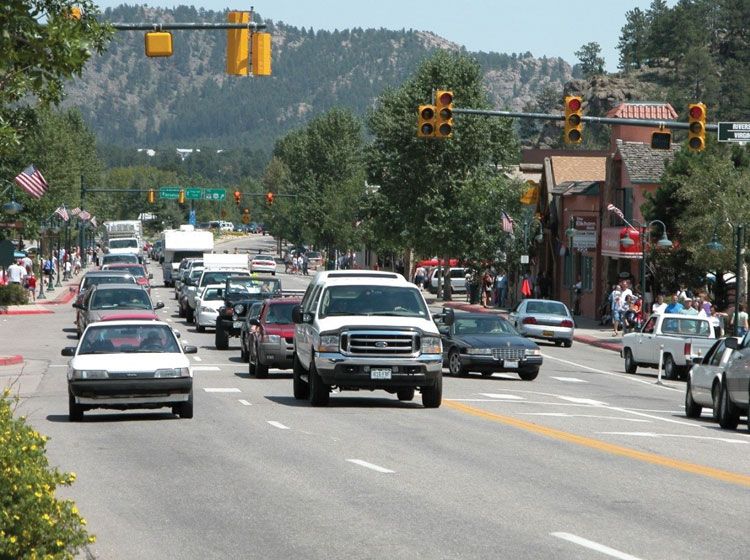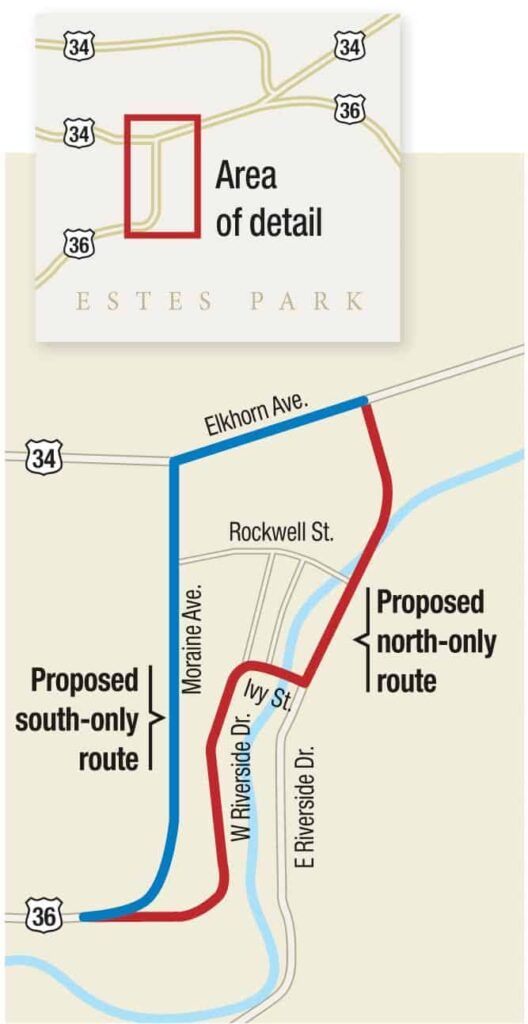8 years later, project still drives Estes loopy

ESTES PARK — Eight acrimonious years after the plan first was proposed and nearly 2½ years after it narrowly won the Town Board’s approval, Estes Park still wrestles with costs and controversy over turning parts of three downtown streets into a one-way loop to ease summer traffic congestion and aid visitor access to Rocky Mountain National Park.
Costs of property acquisition for the right-of-way have more than doubled, a possible legal challenge looms regarding compliance with Colorado’s Taxpayer Bill of Rights, and a deadly pandemic that forced the shutdown of overnight accommodations — the mountain tourist town’s primary source of tax revenue — have complicated completion of the project and reawakened talk in some quarters about whether the project should even continue.
And yet the Colorado Department of Transportation has completed purchase of six of the seven privately-owned parcels it needs to build the one-way couplet, and negotiations continue between CDOT and the property owner for the seventh parcel. Some of the buildings on those tracts already have been demolished, and Public Works Director Greg Muhonen said he still expects work to start around “October-ish” of 2021 and be completed in time for the peak of the summer tourist season in 2022.
SPONSORED CONTENT
The many benefits of simple, coordinated healthcare
Kaiser Permanente combines health care and coverage in one connected system to maximize employee health and minimize employer costs.
 Under the downtown loop plan, westbound U.S. Highway 36 traffic, toward the national park, will use the currently designated route — west along Elkhorn Avenue through the downtown core of tourist shops and restaurants, then south and west on Moraine Avenue — but eastbound U.S. 36 will be diverted at the Moraine Avenue curve through a new roundabout onto West Riverside Drive, across a new bridge over the Big Thompson River at Ivy Street, then north on East Riverside Drive to reconnect with Elkhorn east of downtown.
Under the downtown loop plan, westbound U.S. Highway 36 traffic, toward the national park, will use the currently designated route — west along Elkhorn Avenue through the downtown core of tourist shops and restaurants, then south and west on Moraine Avenue — but eastbound U.S. 36 will be diverted at the Moraine Avenue curve through a new roundabout onto West Riverside Drive, across a new bridge over the Big Thompson River at Ivy Street, then north on East Riverside Drive to reconnect with Elkhorn east of downtown.
Loop proponents pointed to the opportunity to snare Federal Lands Access Program funding to mitigate the ever-increasing summer traffic headaches as tourists head for a national park that has become the nation’s third most visited, drawing more than 4.6 million visitors last year. The project also would include building flood-resilient infrastructure at two bridges along Riverside and widening and deepening the Big Thompson River’s channel. That work would alter the designated floodplain, decreasing flood-insurance premiums for more than 20 properties.
Adam Shake, president and chief executive of the Estes Park Economic Development Corp., said the EDC “has never taken a position on whether to advocate or not for the Loop other than the recognition that, in some of those Loop dollars, there is some infrastructure mitigation in reference to the floodplain. We are very much in favor of that.”
Opponents for years have countered that the plan would disturb the peace of homes, rental cottages and two city parks along Riverside as well as hurting businesses along East Elkhorn, the main downtown commercial street, by speeding tourists leaving the park out of town and away from its economic generators. To get back to the downtown core, they’ve argued, eastbound tourists leaving the park would have to circle back around — and town residents also would have to deal with the inconvenience of the counterclockwise pattern during the offseason when the summer congestion the Loop was meant to alleviate doesn’t exist.
Muhonen said the cost of right-of-way acquisition has risen from $3.4 million to $7.1 million, which “completely overwhelmed” the contingency funding FLAP had put aside to cover overruns. The Central Federal Lands Highway Division “is drafting an amendment for the town to consider,” said town spokeswoman Kate Rusch. “The amendment will include an updated project cost estimate.” Even so, she added, “the town contribution is not expected to increase beyond the $4.2 million obligated under the existing agreement,” and Muhonen said “there’s no make-or-break piece in here” for the project’s future.
Outgoing Mayor Todd Jirsa pointed out that no federal appropriation has been issued yet, and only local and state money has been spent so far. “Given all the deficits going forward because of the economic stimulus due to the coronavirus, will there be money left for these projects?”
A bigger issue, he said, revolves around TABOR. The law enacted by voters in the 1990s specifies that local agencies can’t undertake multi-year agreements.
“We can only make appropriations year to year,” he said. “The original contract with Central Federal Lands did not contain a TABOR clause. According to the town’s attorney, it should have. We have gone back and asked Central Federal Lands to provide a new contract with a TABOR clause in it because it’s required by state statute. The clause would say something along the lines of ‘The future of this contract is contingent on future appropriations.’
“At this point, the federal government has said, ‘Well, we don’t know if we can do this. We’ll get back to you in June. And, oh, by the way, there are hundreds of contracts with municipalities in Colorado that don’t contain the TABOR clause.’ The question is, how can that possibly be? Whether you believe in TABOR or not is not the issue.”
Jirsa said the majority of the town board agreed earlier this year that if the new contract didn’t come out with a TABOR clause, the federal contract probably should be canceled.
“If the Loop is in jeopardy,” Jirsa said, “it’s probably in jeopardy more for that reason than anything else.”
If the Loop plan were to be canceled, what do you tell the property owners whose land and buildings already have been acquired and cleared? Would the town face liability?
As he understands rulings by the U.S. Supreme Court, Jirsa said, “Even though we used eminent domain to take these properties from these people, because they were paid a fair market value for their property, they had no claim going forward.”
Not all the properties thought the price they got was fair.
The tiny Donut Haus, which sat directly on the Moraine Avenue curve and drew early-morning crowds of locals and tourists alike for more than 40 years, already has been acquired and demolished to make way for a roundabout that is to create the connection between Moraine and West Riverside.
“The state did the eminent-domain thing with them and then offered them a really small price,” said Debra Samuels, who works as a bookkeeper for the Donut Haus’ sister business in Loveland. “No way they could have opened another shop based on the amount of money the state was offering them. They gave them maybe a tenth of what it was going to cost.”
The bakery has found a new home at a Sinclair gasoline station farther west on the U.S. 36 stretch of Moraine.
“Does my heart go out to those folks” whose property was taken “if we don’t build this project? Of course,” Jirsa said, “But I think there’s some much bigger legal questions in the offing.”
After a January study session, Muhonen told the Estes Park Trail-Gazette that “the downtown Estes Loop has the potential to deliver to the town a completed project valued at $20 million including roadway and traffic flow improvements, environmental benefits by way of reduced congestion, pedestrian safety upgrades, as well as upgrades to help with future flood mitigation. … At this critical juncture, the Town Board must objectively consider the benefits of this project and decide the best path forward.”
ESTES PARK — Eight acrimonious years after the plan first was proposed and nearly 2½ years after it narrowly won the Town Board’s approval, Estes Park still wrestles with costs and controversy over turning parts of three downtown streets into a one-way loop to ease summer traffic congestion and aid visitor access to Rocky Mountain National Park.
Costs of property acquisition for the right-of-way have more than doubled, a possible legal challenge looms regarding compliance with Colorado’s Taxpayer Bill of Rights, and a deadly pandemic that forced the shutdown of overnight accommodations — the mountain tourist town’s…
THIS ARTICLE IS FOR SUBSCRIBERS ONLY
Continue reading for less than $3 per week!
Get a month of award-winning local business news, trends and insights
Access award-winning content today!


